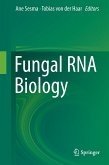This book presents an overview of the RNA networks controlling gene expression in fungi highlighting the remaining questions and future challenges in this area.
It covers several aspects of the RNA-mediated mechanisms that regulate gene expression in model yeasts and filamentous fungi, organisms of great importance for industry, medicine and agriculture. It is estimated that there are more than one million fungal species on the Earth. Despite their diversity (saprophytic, parasitic and mutualistic), fungi share common features distinctive from plants and animals and have been grouped taxonomically as an independent eukaryotic kingdom. In this book, 15 chapters written by experts in their fields cover the RNA-dependent processes that take place in a fungal cell ranging from formation of coding and non-coding RNAs to mRNA translation, ribosomal RNA biogenesis, gene silencing, RNA editing and epigenetic regulation.
It covers several aspects of the RNA-mediated mechanisms that regulate gene expression in model yeasts and filamentous fungi, organisms of great importance for industry, medicine and agriculture. It is estimated that there are more than one million fungal species on the Earth. Despite their diversity (saprophytic, parasitic and mutualistic), fungi share common features distinctive from plants and animals and have been grouped taxonomically as an independent eukaryotic kingdom. In this book, 15 chapters written by experts in their fields cover the RNA-dependent processes that take place in a fungal cell ranging from formation of coding and non-coding RNAs to mRNA translation, ribosomal RNA biogenesis, gene silencing, RNA editing and epigenetic regulation.
From the book reviews:
"In this volume, the editors have brought together contributions from a broad spectrum of research groups with the aim of providing 'a valuable resource for students and researchers studying RNA-dependent processes' ... . The editors are to be congratulated on producing a scholarly and in-depth review, which will be a boon to not only fungal cell biologists, but those concerned with the molecular biology of eukaryotes generally." (Ima Fungus, Vol. 5 (1), June, 2014)
"In this volume, the editors have brought together contributions from a broad spectrum of research groups with the aim of providing 'a valuable resource for students and researchers studying RNA-dependent processes' ... . The editors are to be congratulated on producing a scholarly and in-depth review, which will be a boon to not only fungal cell biologists, but those concerned with the molecular biology of eukaryotes generally." (Ima Fungus, Vol. 5 (1), June, 2014)








